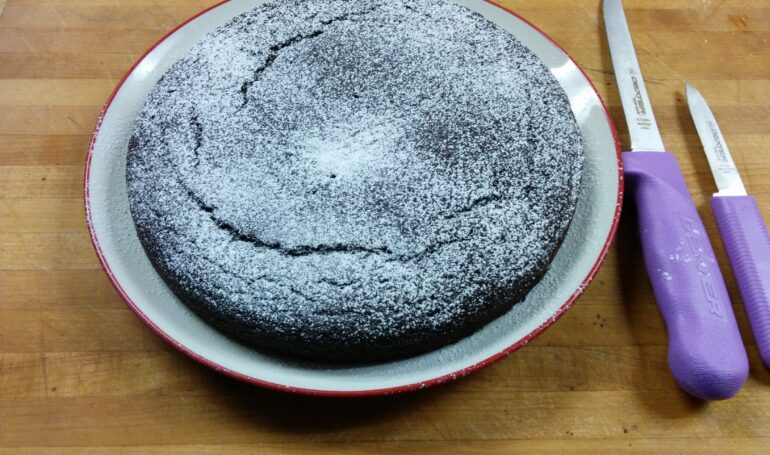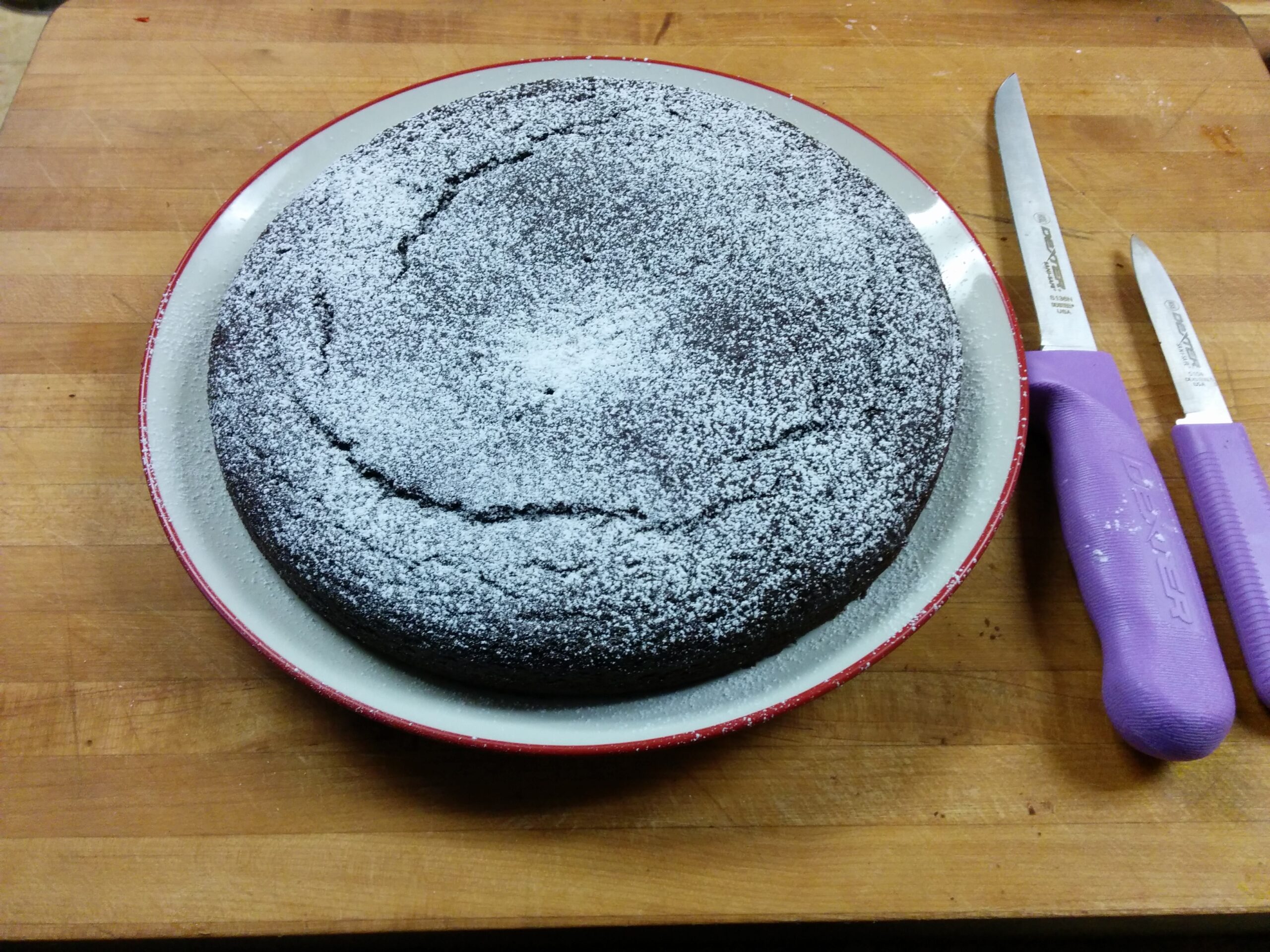
It is vegan, but is it healthier?
I received a free copy of Food and Nutrition Magazine. The cover boasts a beautiful cake. It is sitting on a mint-green pedestal frosted with what appears to be a decadent and rich chocolate ganache. The three avocados sitting discreetly in the background are the only hint about the ingredients in this cake.
I looked at that cake a bit incredulously. It is a odd to see a chocolate cake gracing the cover of a publication for the Academy of Nutrition and Dietetics. To make the cut as a healthy dessert, I figured it was either filled with fake ingredients like sugar substitute or some ‘super food’ like ground chia seeds. Thankfully, the recipe leaves the artificial ingredients behind. Save for the coconut oil and coconut sugar, for the most part, no super food fads were in sight. Included in a feature called “Fruit and Vegetable Desserts: Have Your Cake and Eat It, Too!” this was a “Vegan Beet Cake with Chocolate Avocado Frosting.”
Since I had an abundance of winter beets on hand from my winter farm share, I thought the idea of a natural red velvet cake sounded intriguing. Not being a vegan myself, I took the liberty to modify the recipe to ingredients I had on hand (see below). And, in the interest of using as many beets as possible, I added as many as I thought I could get away with.

This was, hands-down, one of the best chocolate cakes I have ever made. It was moist. It was chocolaty. There is the perfect amount of baking soda and baking powder to give this cake a nice springy spong. While the first slice did maintain a beet flavor, but that mellowed out after a day or two. Personally, even thought the frosting was so attractive on the cover, I opted to skip it. The cake was delicious naked.
Although using winter beets in sneaky ways was my main motive, I wondered about how healthy this cake really was. Just because something is vegan, it does not automatically make it healthy. Face it, dessert is dessert and anything sugar laden is not necessarily healthier even if eggs and dairy are omitted.
So, I decided to compare this cake to several other chocolate cakes. To make things as equal as possible I compare it to recipes that had between 1-1/5 and 2 cups of flour and 8 servings. I am embarrassed to say how long I spent on this little project, but it is all in the name of science, right? Fortunately, MyFitnessPal.com has a handy recipe reading tool. All you have to do is past in a URL and it automatically detects the recipe and calculates the calories per serving.
For the purposes here, I looked at the calories and macronutrients – fat, carbohydrates, protein and fiber. I am sure there are many opinions on good fats versus bad fats or good sugars versus bad sugars and high protein and vitamins and minerals and so much more, but seriously folks, THIS IS DESSERT. The question is. . . Can I have two slices for the price of one?
In all categories, this vegan beet cake out performs all of the other chocolate cakes I checked. This is mostly because it comes in at only 277 calories, which is much lower than other recipes. It also has 14g of fat, 19g of sugar, 7g of fiber and 6g of protein per slice (cake only, no frosting). On one extreme, a dark chocolate cake from Martha Stewart’s website comes in at 617 calories, 34g of fat, 49g of sugar, 4g of fiber and 8g of protein per slice. Closer in calories to the vegan beet cake is the flourless chocolate cake from the same website with 320 calories, but it weighs in at 24g of fat and 23g of sugar and only 2g of fiber. The middle of the road is Mom’s Chocolate Cake from FoodandWine.com with 474 calories, 18g of fat. 50g of sugar, 3g of fiber and 7g of protein.
This was not an exhaustive comparison, but it set my mind at ease that my new discover, the not-quite-vegan beet cake, was a healthier indulgence. And yes, you could have two slices (or three)! Just for reference, the vegan version is even healthier.
Not-Quite-Vegan Beet Chocolate Cake (adapted from Food and Nutrition)
Ingredients
Cake (wet ingredients):
1.25 cup roasted beets, pureed (about 3 to 4 small, .75lb raw)
1 cup non-fat milk
2.5 tablespoon buttermilk powder
1⁄3 cup coconut oil, melted
2 ounces bittersweet chocolate (melted with coconut oil)
3⁄4 cup organic cane sugar
2 teaspoons vanilla extract
Cake (dry ingredients):
1 1⁄2 cups whole-wheat pastry flour
1⁄2 cup unsweetened, natural cocoa powder (+ extra for dusting pan)
1 teaspoon baking powder
1 teaspoon baking soda
1⁄4 teaspoon salt
Butter for greasing pan.
Directions
- Preheat oven to 400°F.
- Clean and scrub beets, trim ends and dry. Roast in a covered pan (preferably glass) for 50-60 minutes. Allow to cool. Puree in a food processor until smooth.
- Reduce oven to 350°F. Line the bottom of a 9-inch springform pan with parchment. Grease lightly with butter and dust with cocoa powder.
- Add buttermilk powder to milk and stir. Whisk.
- In a large bowl, sift together dry ingredients and set aside. In a separate bowl, use a hand or stand mixer to cream coconut oil, bittersweet chocolate and sugar.
- Add pureed beets, milk mixture and extract. Mix until smooth.
- Add the wet mixture to the dry ingredients and stir just until combined. Pour into the greased pan.
- Bake for 25-30 minutes or until cake pulls away from the sides and a toothpick inserted into the center comes out clean.
- Allow to cool in pan for 5 minutes. Remove from spring-form and gently lift off pan with parchment. Allow to cool completely on the cooling rack.
Leave a Reply